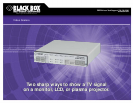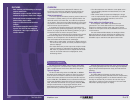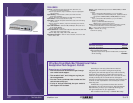
2 of 3
7/3/2007
#20510
724-746-5500 blackbox.com
FEATURES
• Both models provide scaling to multiple
output resolutions.
• Selectable output vertical refresh rates
enable the brightest, flicker-free images.
• Advanced motion compensation when
deinterlacing input video.
• Support wide-screen and letterbox
images.
• Switchable composite and S-Video
inputs. The AC217A also supports
component video input and RS-232
remote control.
OVERVIEW
Our Video Scalers convert standard TV video to non-
interlaced, high-resolution images that exactly match the
native resolution of any HDTV, DTV, or plasma projector.
What is interlacing?
A TV video signal is interlaced, meaning each full screen of
information is actually made up of two separate fields—the
odd field and the even field. First, the odd lines are painted
on the screen. Then, before the odd lines fade, the even lines
are painted in between the odd lines. This all happens faster
than the human eye can perceive.
In contrast, the computer signal is non-interlaced—the
horizontal lines are painted progressively, left to right, top to
bottom, in a single pass. So the flickering problem you get in
interlaced TV does not exist in computer video.
Line doublers and quadruplers were developed to convert
interlaced TV signals to non-interlaced computer signals.
However, when compared to line doublers or quadruplers,
both video scalers offer several clear advantages:
• When using a video scaler, a projector or display device is
not forced to crop, distort, or further process the image in
order to display it.
• The video scalers can provide outputs at multiple refresh
rates. For example, a video scaler can display converted
PAL video on projectors that don’t support 50-Hz refresh
rates. Or converted video can be displayed at 75 Hz,
eliminating flicker.
The Advanced Video Scaler and Intelligent Video Scaler
convert images from a TV screen onto a computer monitor,
LCD, or plasma screen. Here’s more about how they work.
Types of signals.
TV video is defined by either the NTSC, PAL, or SECAM
standard, which dictates the number of lines in the picture,
how the color information is defined, and the speed with
which the lines are painted on the screen (refresh rate). But
within NTSC, PAL, and SECAM, there are several formats that
meet these standards. Composite video is most commonly
used, with video information for red, green, and blue (RGB)
and sync combined into a single signal. S-Video, which
separates the chrominance (color) from the luminance and
sync information, provides a superior picture.
Technically Speaking
• The video scalers are not limited to a 4:3 aspect ratio—
they can display letterbox-formatted video, too (16:9
aspect ratio).
• With a video scaler, projectors and displays no longer
have to reprocess the output of a doubler or quadrupler
to match their own native resolution, so the final
displayed image is sharper.
Video scaling the intelligent way.
The Intelligent Video Scaler represents the next
generation in our video scaler solutions. It incorporates
support for component video input and output, lockout
function of front-panel controls, and RS-232 remote control
of all functions.
Like the Advanced Video Scaler, the Intelligent Video
Scaler eliminates on-screen artifacts (such as black lines)
associated with line doubler conversion. It also features
selectable output resolutions and aspect control ratio.
AC217A also supports component video, which carries the
color and brightness portions of the video signal as separate
signals. This provides superb color clarity and reduced color
bleeding.
How they work.
The Video Scalers will accept any video source, de-
interlace it with proprietary, advanced motion compensation,
and then intelligently scale it to the desired resolution with
virtually no artifacts. All you need to do is set the output
resolution to match the native resolution of the connected
LCD, DLP, or plasma projector or display.





